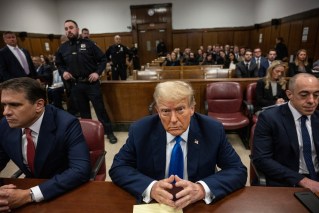Doctor says George Floyd died from lack of oxygen
George Floyd died of a lack of oxygen from being pinned to the pavement with a knee on his neck, a medical expert has testified at former Officer Derek Chauvin’s murder trial, emphatically rejecting the defence theory that Mr Floyd’s drug use and underlying health problems were what killed him.
“A healthy person subjected to what Mr Floyd was subjected to would have died,” said prosecution witness Dr Martin Tobin, a lung and critical care specialist at the Edward Hines Jr VA Hospital and Loyola University’s medical school in Illinois.
Dr Tobin told the jury on Thursday that Mr Floyd’s breathing was severely constricted while Mr Chauvin and two other Minneapolis officers held the 46-year-old black man down on his stomach last May with his hands cuffed behind him and his face jammed against the ground.
The lack of oxygen resulted in brain damage and caused his heart to stop, the witness said.
Dr Tobin, analysing images of the three officers restraining Mr Floyd for what prosecutors say was almost nine-and-a-half minutes, testified that Mr Chauvin’s knee was “virtually on the neck” for more than 90 per cent of the time.
Mr Chauvin kept his knee on Mr Floyd’s neck for three minutes and two seconds after Mr Floyd had “reached the point where there was not one ounce of oxygen left in the body”, Dr Tobin said.
As prosecutors repeatedly played a video clip of Mr Floyd on the ground, Dr Tobin pinpointed what he said was a change in the man’s face that told him Mr Floyd was dead. That moment happened about five minutes after police began holding Mr Floyd down.
“At the beginning you can see he’s conscious, you can see slight flickering, and then it disappears,” Dr Tobin said. “That’s the moment the life goes out of his body.”
Mr Chauvin, 45, is charged with murder and manslaughter in Mr Floyd’s death on May 25. Mr Floyd was arrested outside a neighbourhood market after being accused of trying to pass a counterfeit $US20 note.
Bystander video of Mr Floyd crying that he could not breathe as onlookers yelled at the white officer to get off him sparked protests and scattered violence around the US.
In his testimony, Dr Tobin explained that just because Mr Floyd was talking and shown moving on video did not mean he was breathing adequately. He said a person could continue to speak until the airway narrowed to 15 per cent, after which “you are in deep trouble”.
Officers can be heard on video telling Mr Floyd that if he can talk, he can breathe.
During cross-examination, Chauvin lawyer Eric Nelson pressed Dr Tobin on that common misconception, pointing to earlier testimony that Minneapolis officers are trained that if people can speak, they can breathe.
Mr Nelson has argued Chauvin did what he was trained to do and that Floyd’s death was caused by illegal drugs and underlying medical problems that included high blood pressure and heart disease. An autopsy found fentanyl and methamphetamine in his system.

George Floyd, 46, worked as a security guard at a Minneapolis bistro and coached basketball and football in his spare time.
But Dr Tobin said he analysed Mr Floyd’s respiration as seen on body-camera video and explained that while fentanyl typically cut the rate of respiration by 40 per cent, Mr Floyd’s breathing was “right around normal” just before he lost consciousness.
Another prosecution witness, Dr Bill Smock, an expert on deaths from asphyxia, backed up Tobin’s assessment. Dr Smock said Mr Floyd did not have symptoms of a fentanyl overdose such as constricted pupils and decreased breathing. He said Mr Floyd’s actions were the opposite because he was pleading for air.
-AAP







